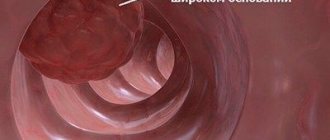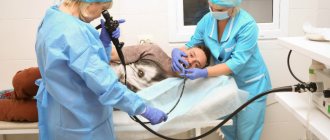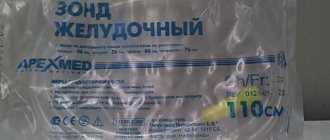Palpation of the stomach
The stomach is palpated in the epigastric region with four half-bent fingers of the right hand folded together. They are installed 3-5 cm below the xiphoid process parallel to the position of the greater curvature of the stomach (Fig. 56, a). A superficial movement of the fingers upward to the xiphoid process first creates a skin fold. Then, as the patient exhales, the fingertips are immersed deep and, upon reaching the spine, they slide from top to bottom. While the fingers are above the stomach, you can feel the rumbling. It is caused by the movement of fluid and gases in the stomach, caused by deep sliding palpation.
Respiratory excursions contribute to better palpation of the stomach. Therefore, the patient must be asked to calmly and deeply “breathe with his stomach.” During the exhalation phase, the greater curvature of the stomach goes up, and the examiner’s fingers move down and slide off a small elevation in the form of a step formed by a duplicate of the greater curvature, which is felt at this moment as a soft elastic arc-shaped roller located on both sides of the spine.
To find the greater curvature, you can use the “double-handed” palpation method (Fig. 56, b). For this purpose, the fingertips of the left hand are placed on the terminal phalanges of the right hand and deep sliding palpation is performed with them. Normally, the greater curvature of the stomach is located 3-4 cm in men, 1-2 cm above the navel in women and is palpable in 50-60% of cases. When the stomach prolapses, it may lie below the navel
Rice. 56. Palpation of the stomach: a, b - greater curvature in the usual way and the “double hand” method; c — by palpation auscultation; d - percussion method; d - with the patient in an upright position.
The correctness of finding the greater curvature is checked by comparing palpation data with the results obtained using other methods of studying the lower border of the stomach.
When palpating the stomach, in addition to determining its location, you should pay attention to the consistency, surface and shape, as well as the presence of pain. In healthy people, the surface of the stomach is smooth.
Thickening of the greater curvature and pain during palpation are observed with gastritis and peptic ulcer disease. If a stomach tumor develops, its shape and consistency change, and the surface becomes lumpy. This is better revealed by palpation of the stomach in an upright position of the patient (Fig. 56, e).
To determine the lower border of the stomach
percussion palpation according to Obraztsov is used (according to the splashing noise; Fig. 56, d). The splashing noise can be caused if there is liquid and air in the stomach and if the latter is located in front of the liquid. To detect the splashing noise, use the elbow edge of the slightly bent left hand to press in the area of the xiphoid process. In this case, the air of the gas bubble will be distributed over the surface of the liquid. Next, with four half-bent fingers of the right hand, short blows are made in the epigastric region, slightly below the xiphoid process, and, gradually descending downwards, they cause a splashing noise until the fingers slide off the greater curvature of the stomach. The cessation of the splashing noise indicates the lower border of the stomach.
In healthy people, splashing sounds are produced shortly after eating. If a loud splashing noise is caused on an empty stomach or 6-7 hours after a meal, it means that the motor function of the stomach is reduced or its evacuation ability is impaired. This may be due to spasm or pyloric stenosis.
In addition to deep sliding and percussion palpation, the method of palpation auscultation can be used to determine the lower border of the stomach (Fig. 56, c). It comes down to this. The stethoscope is placed over the stomach area. Using the index finger of the right hand, make light rubbing movements along the abdominal wall from top to bottom towards the navel. While the finger is above the stomach, a rustling sound is heard in the stethoscope, which disappears or weakens when the finger goes beyond it. This simple method can determine the position of the greater curvature of the stomach, but sometimes it gives incorrect results.
The location of the lower border of the stomach can normally change depending on the degree of filling of the stomach and intestines, the person’s fatness, changes in intra-abdominal pressure and other reasons. A significant displacement of the lower border of the stomach during its expansion and descent acquires diagnostic significance.
Palpation of the stomach from 0:22 (marked):
The stomach and intestines are the most important parts of the digestive tract, which we pay attention to only when they do not function and we experience discomfort. Our civilized way of life, unfortunately, does not facilitate the work of the stomach and intestines - office work, fast food and limited mobility lead to typical symptoms, such as constipation. Colon cancer is the third most common cancer in Germany after breast cancer and lung cancer.
Digestive tract
The human digestive tract includes all organs that provide:
- eating;
- its grinding;
- passing;
- breakdown into nutritional elements;
- suction.
After the mouth, pharynx and esophagus comes the stomach , an organ with numerous functions.
Stomach acid and enzymes perform the following functions:
- break down protein;
- begin protein processing;
- acidic gastric juice kills almost all bacteria;
- all solid particles of food remain in the stomach for so long until they move and become liquid;
- then the pulp (chyme) moves into the intestines.
In the first section of the intestine ( duodenum ), juices from the gallbladder and pancreas are mixed - now fat digestion can begin. In the next section of the intestine, nutrients are absorbed, and the next section only absorbs liquid with electrolytes dissolved in it. During the daily digestion process, about ten liters of liquid (drink, saliva, gastric juice, bile, pancreatic secretions, intestinal juices) enter the intestines, which must be absorbed back; if this system is disrupted, diarrhea and dehydration threaten to occur.
Complaints from the stomach and intestines
We have experienced some common diseases of the digestive tract from our own experience. They cause a few days of feeling unwell, but can be managed with home remedies, bed rest and drinking plenty of fluids. Complaints from the stomach and intestines are very diverse, they indicate different symptoms and often occur in combination. It is very rare for someone to have only pain or only diarrhea as their only symptom.
Frequent complaints and symptoms are:
- pain;
- feeling of tightness or fullness;
- heartburn;
- nausea;
- vomiting stomach contents or blood;
- flatulence;
- diarrhea;
- hiccups;
- burning sensation;
- blood or mucus in the stool and other stool changes.
What happens differently is if there is no improvement - severe gastrointestinal infections with fever (indicating infection), inflammation of the stomach lining (gastritis) or stomach or duodenal ulcers require seeking professional help.
Chronic diseases
- By chronic diseases we mean:
- irritable bowel or stomach syndrome;
- lactose (milk sugar) intolerance;
- food allergies are common diseases characterized by recurring diarrhea
- after eating certain foods;
- Crohn's disease;
- celiac disease (congenital sprue);
- a systemic disease such as porphyria;
- eating disorders in the form of unnatural eating behavior leads to persistent symptoms from the gastrointestinal tract.
Acute diseases
In some diseases, it is forbidden to wait several days until improvement occurs on its own; on the other hand, the manifestations of the disease are often so critical that no one dares to wait. Experts talk about acute abdomen and mean suddenly developed diseases that can be life-threatening without treatment. Here it is worth mentioning:
- stomach bleeding;
- inflammation of the cecum;
- intestinal obstruction (ileus);
- inflammation of the pancreas (pancreatitis).
Although the latter is located only near the stomach and intestines, its inflammation greatly disrupts their functioning.
The presence of blood in stool is characterized by:
- diverticula;
- haemorrhoids;
- bowel cancer.
The latter, however, can develop for a long time without visible signs - which is why annual screening for bowel cancer is so important.
Stomach and intestines: examination and treatment
- History : All complaints should be clarified using a targeted interview, also called medical history. For example, pain can be in the epigastrium or in the navel area, it can be spastic or constant, or it can occur before or after eating. Clarifying all these differences will allow the doctor to make the correct diagnosis, since different diseases have different symptoms - and complaints expressed by the patient.
- Inspection, palpation, percussion and auscultation : No one can fail to notice a distended abdomen with flatulence. Palpation of a painful abdomen helps the doctor more accurately determine the cause. A full intestine is characterized differently than an empty one; resistance on the part of the patient (protective tension) during palpation allows us to draw a conclusion about the disease. Tapping on the abdomen can reveal fluid between the loops of the intestines; during auscultation, the intestines “play music” with splashing, rumbling sounds or do not make sounds at all - which may be a sign of constipation. With constant complaints, there is nothing left but to carry out further diagnostics; In addition to blood and urine tests, sometimes invasive examination techniques are also necessary.
- Blood tests/breath tests : Many bowel diseases affect the blood picture and its parameters. A blood test determines whether inflammatory markers are increased or whether red blood pigment levels (hemoglobin levels) are decreased (for bleeding). A breath test can detect the presence of stomach bacteria Helicobacter, the most common cause of stomach inflammation and ulcers.
- Endoscopy of the stomach and intestines (gastroscopy and colonoscopy) : During gastric endoscopy (gastroscopy), a thin tube is inserted through the mouth and esophagus into the stomach. A small camera provides an overview of the stomach cavity. This is how an accurate examination of the condition of the mucous membrane of the esophagus and stomach is carried out. Suspicious-looking areas are taken for analysis (biopsy). Stomach bleeding can be stopped with this tube. It is even possible to conduct an ultrasound examination of the liver and pancreas using gastroscopy. Intestinal endoscopy (colonoscopy) is performed for the small intestine through the mouth and esophagus, and for the large intestine through the anus. In addition to examination and biopsy, it is also possible to remove polyps (outgrowths of the intestine).
- Ultrasound, X-ray, computed tomography (CT) and magnetic resonance imaging (MRI) : Ultrasound shows single intestinal loops, as well as free fluid contained in the case of some diseases outside the intestine. X-rays in a standing position reveal, for example, free air under the dome of the diaphragm when a gastric ulcer is perforated. Computed tomography or magnetic resonance imaging creates an image of the body from many thin “cuts” so that subtle changes and ulcers can be detected.
- Proper nutrition : In addition to things that common sense might suggest, such as eating easily digestible foods or not eating, drinking plenty of fluids and resting in bed, common home remedies - teas, heating pads and natural remedies for feeling full, flatulence and constipation - also help. Interestingly, hot spices can relieve pain in a sensitive stomach. By the way, did you know that sleeping on your left side can relieve heartburn? For some diseases - celiac disease or lactose intolerance - it is worth giving up foods that correspond to the disease. It goes without saying that for each disease there is a special approach in terms of diet, medications or other possible measures such as hospitalization, infusion therapy or surgery.
- Nutrition, treatment, cancer screening . Nutrition, treatment, cancer screening - these are the three most important provisions for a healthy gastrointestinal tract:
- Eating foods rich in ballast substances - a sufficient amount of vegetables and fruits - stimulates digestion and is recognized as protection against cancer and diverticulosis. It is nutrition that is currently assessed as an important factor in carcinogenesis;
- physical activity protects the intestines during its daily work; for a short warm-up during the break, a program consisting of 20 elements is proposed. This keeps the intestines moving and flatulence and constipation can be avoided. In addition, movement and relaxation exercises are a balm for the soul and body for stress-related diseases such as gastritis or irritable bowel;
- Cancer screening is a sensitive topic. Bowel cancer is common, but unfortunately it is mostly detected very late; and in the early stages it can be treated - in the case when free screening was carried out! Unfortunately, only every sixth man and every second woman use this early detection tool.
If you have doubts or real concerns about your health, contact our clinic for a free consultation or second opinion. The Clinic of Gastroenterology, Oncology and General Internal Medicine of the City Clinical Hospital of Solingen, Germany is one of the best in Europe.
How to contact us
Email: [email protected] Tel.: +49 212 5476913 Viber | WhatsApp: +49 173-2034066 | +49 177-5404270 For your convenience, please save the phone number in your phone book and call or write to us for free on WhatsApp, Viber or Telegram. Applications made on weekends or holidays will be processed on the first business day.
Stomach tumor: signs, symptoms and diagnosis
A stomach tumor is a complex disease that poses a threat to human life. It represents the appearance of formations on the gastric walls, which can be benign or malignant. Modern medicine and advanced equipment make this disease curable. The main thing is to promptly notice its signs, carry out diagnosis and proper treatment.
Benign formations, their signs and symptoms
Approximately 5-10% of all neoplasms on the gastric wall are benign tumors, and 90-95% are malignant. The first type includes formations that grow and develop quite slowly. However, they are characterized by a favorable prognosis. However, if they are not identified in a timely manner and treatment is not started, they can develop into dangerous neoplasms. Therefore, it is important to monitor your health and identify the first symptoms in time.
Different types of benign stomach tumors have different signs and symptoms. In most cases, such ailments practically do not manifest themselves at all. They can be identified during endoscopic examination.
When asking the question of how to indicate the degree of the disease, you should understand what types of tumors are found. The following types of benign diseases are distinguished:
- polyps;
- leiomyomas;
- lipoma;
- neuroma;
- angioma;
- fibroma.
The first type is most common. It can be single or multiple. How to identify this species? In this case, the following ailments are observed:
- nagging or aching pain that occurs in the epigastric region (they occur after eating or 1-3 hours after eating);
- belching after eating air or food;
- the appearance of nausea or vomiting reactions;
- discomfort in the sternum and burning;
- heartburn;
- frequent weakness, dizziness, loss of strength, rapid fatigue (this may be caused by hidden bleeding from the polyp).
The second type of neoplasm is leiomyoma. This tumor in the stomach does not have any symptoms. Signs of this disease may occur when part of the tumor dies or an ulcer appears on it. This leads to hidden bleeding in the stomach and the appearance of the following symptomatic manifestations:
- dizziness;
- frequent weakness and loss of strength;
- anemia;
- sudden weight loss.
The exact cause of the appearance of these benign formations has not yet been identified. However, most often the following factors lead to them: chronic gastritis, bad habits, poor environment, infection, decreased immunity, heredity.
Dangerous tumor: symptoms
Malignant neoplasms differ from benign ones in that their cells already differ from the type of cells of the organ on which the tumor arose. Such formations have partially or completely lost the ability to differentiate. They are a serious threat to human life. Malignant tumors appear especially often in men aged 50-70 years.
Depending on the stages of the disease (early or late), its symptoms also differ. Thus, an early symptom of a stomach tumor can be identified by the following ailments:
- loss of appetite;
- sudden weight loss;
- feeling of a full stomach;
- the occurrence of pain, as well as a feeling of heaviness felt in the upper abdomen (this is especially pronounced after eating);
- the appearance of a feeling of disgust for certain foods (for example, meat).
At a late stage, a malignant tumor of the stomach has completely different symptoms. At this stage, intoxication of the body occurs. It is called tumor or cancer. How to determine this stage? In this case, you can notice the following first signs of a stomach tumor:
- depressive states, general weakness of the body, lack of a sense of joy, fatigue, decreased or loss of interest in work and work;
- frequent headaches, slow reactions, dizziness, poor sleep at night, desire to sleep during the day;
- severe loss of appetite (can lead to anorexia or cachexia);
- pale, blue or yellowing of the skin;
- causeless increase in temperature;
- dry mouth, eyes and nose;
- excessive sweating (especially at night);
- deterioration of immunity and resistance to various diseases;
- anemia;
- causeless nausea and vomiting reactions;
- sudden abdominal pain, heaviness in the gastric region (especially severe after eating);
- vomiting of foods eaten the day before (accompanied by an unpleasant rotten odor);
- enlarged lymph nodes located in the neck;
- the presence of blood discharge in the stool.
Diagnosis of the disease
If you notice any symptoms of the disease, you should immediately consult a doctor. It will qualitatively and accurately identify a stomach tumor; diagnosis will be carried out using various methods. During this process, all problems and malfunctions in the body will be identified. This will help avoid serious health problems, and in some cases even save lives.
One of the reliable and advanced institutions where you can diagnose the gastrointestinal tract is the Road Clinical Hospital at the station. Bitter". It has the latest equipment that can give the most accurate results. Thus, the device with which the research is carried out is a special endoscope Exera III. It is manufactured by Olympus.
How to diagnose a disease using special equipment? Having decided to check the condition of your gastrointestinal tract using this equipment, you can be confident in the quality and accuracy of the data obtained. In case of stomach problems, a procedure called gastroscopy, which is an upper endoscopy, is performed. During this analysis, the stomach, esophagus and duodenum are examined.
The essence of gastroscopy is as follows. A special device, which is a soft tube with a tiny video camera attached to it, is inserted through the mouth into the human digestive system. As a result, an image of the mucous membrane of the diagnosed organs is displayed on the monitor, and an endoscopic picture appears. If necessary, this image can be enlarged many times, which makes it possible to examine the surface under study in detail.
Diagnosis of a stomach tumor includes not only examination using special equipment, but also the study of various important information about the patient:
- analysis of complaints and symptoms (identification of all ailments that torment the patient);
- analysis of the patient’s life (presence of any gastrointestinal diseases, bad habits);
- family analysis (heredity and predisposition to disease are revealed);
- visual examination of the patient (study of the appearance of the skin, mucous membranes);
- blood test (detects anemia);
- stool test (presence or absence of blood in stool).
It is after identifying the disease that it is worth taking time to study how the tumor is treated. Particular attention to preventive diagnostics should be given to people over 50 years of age. After this milestone, the likelihood of tumor growth is greater than at an early age. Even if there are no complaints or signs, you need to set aside time for the examination. This will help avoid serious problems in the future. Timely identification of problems will make it possible to begin high-quality and effective treatment, thereby preventing the development of benign formations into malignant ones.










